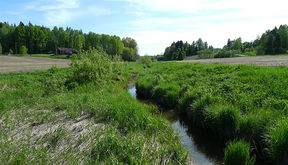Environmental drainage channel decreases amount of substances transported to the water system

In her dissertation, Kaisa Västilä, DSc (Tech) examined the natural-like channel and its impact on the protection of waters. The dissertation was published at the beginning of 2016.
Traditionally, agricultural drainage waters and urban drainage waters are managed by building channels with trapezoid-shaped cross-sections and by dredging and straightening rivers. The objective is to get water to flow away as quickly as possible without causing flooding.
The EU's Water Framework Directive and Floods Directive encourage channel builders to take ecology and water quality into account better than they have been previously. An environmental compound channel has been proposed as the solution.
A compound channel imitates a river in its natural state. It has a main channel flanked by a floodplain covered in vegetation, where water rises when flow increases.
A promising solution
'Our objective is to build channels that are more diverse in nature than at present,' Kaisa Västilä describes.
In addition to meeting biodiversity and water protection objectives, channels must function in a way that allows fields and built areas to remain dry.
For now, compound channels have been built in urban areas to manage flooding. Numerous compound channels intended for agricultural use have been built in the United States, but only a few test channels intended for research have been built in Finland.
According to Ms Västilä, the compound channel is a promising solution for the drainage of fields and the conservation of water systems. Finland's environmental administration and designers have shown interest in this method.
Quality of water improving
Ms Västilä examined the compound channel solution at Sipoo's Ritobäcken brook, which has a catchment area approximately 10 square kilometres in size. The brook, which flows into Sipoonkorpi National Park, gets it water from two lakes and the surrounding fields.
'The brook is of great ecological value even though it has been dredged and straightened throughout the years. A brown trout population lives just below our test area,' Ms Västilä explains.
Ms Västilä researched the flow of water in the Ritobäcken brook for a period of three years. The channel with floodplains functioned in line with objectives.
As flow increased during spring and autumn rains, the water rose to the floodplains and solid substances piled up on the vegetated portions of the plain. As a result, the water's cloudiness and the amount of solid substances in the main channel decreased.
A total of approximately 5.5% of suspended substances transported by water were held up on thetest reach, which was less than 200 meters long. Approximately 20% of suspended substances were held up on a one kilometre long reach. Tall vegetation caused substances to pile up more effectively than short vegetation.
'It is interesting that such great improvements could be achieved in water quality with a floodplain even this small. For example, when compared with wetlands the need for land area was notably smaller,' Ms Västilä reports.
Water off the fields
On the basis of monitoring, a compound channel improved the drainage of surrounding fields.
'Previously, water often rose to the fields even during summer, while now, flooding has been kept in check almost completely. Floodplains can transfer large flows.
'A compound channel has different water depths and flow conditions which facilitate a more diverse vegetation and biota than traditional channels. Vegetation protects soil from erosion and piles substances on plains. Less substances are transported to the downstream reaches, which improves the ecological state of the channel and e.g. the condition of spawning gravels.
Model supports design
Ms Västilä's dissertation work comprised formulating a more detailed version of the model that Staff Scientist Juha Järvelä presented at the Department of Water and Environmental Engineering in the early 2000s. From that time on, the water engineering research group has continued to develop the model.
Modellers around the world describe plants as cylinder-shaped rigid objects. The model developed at Aalto University takes into account the streamlining of trunks, branches and leaves of woody vegetation in the flow, which improves the reliability and accuracy of the model. Additionally, Ms Västilä researched the modelling of grassy vegetation in a compound channel.
'These models will serve both design and research. Without modelling, the channels built may be too large or too small, which will weaken the functionality of the channel and cause unnecessary costs.
Ms Västilä will continue to research this field at Aalto University. Now, she will focus on the transport and retention of nutrients in environmental channels.
'Phosphorous binds itself to substances, and, thus, nutrients are also removed from the water at least where substances pile up on the floodplain.
A new hydraulic flume, which will facilitate more precise research, was installed at the Department of Water and Environmental Engineering in summer 2016.
The Academy of Finland provided primary funding for the dissertation project. In December 2015, Maa- ja vesitekniikan Tuki Ry (the Land and Water Technology Foundation) granted a total of 800,000 euros in funding to nine water engineering research projects.
Kaisa Västilä defended her dissertation on 15 January 2016 at the Aalto University School of Engineering. The dissertation is titled Flow–plant–sediment interactions: Vegetative resistance modeling and cohesive sediment processes .
The dissertation can be found behind the following link: http://urn.fi/URN:ISBN:978-952-60-6597-7
Further information: Kaisa Västilä, tel. +358 50 4081 390, [email protected]
- Published:
- Updated:
Read more news

Get to know us: Associate Professor Maria Sammalkorpi
Sammalkorpi received her doctorate from Helsinki University of Technology 2004. After her defence, she has worked as a researcher at the Universities of Princeton, Yale and Aalto.
Aalto computer scientists in ICML 2024
Computer scientists in ICML 2024
Getting bacteria into line
Physicists use magnetic fields to manipulate bacterial behaviour